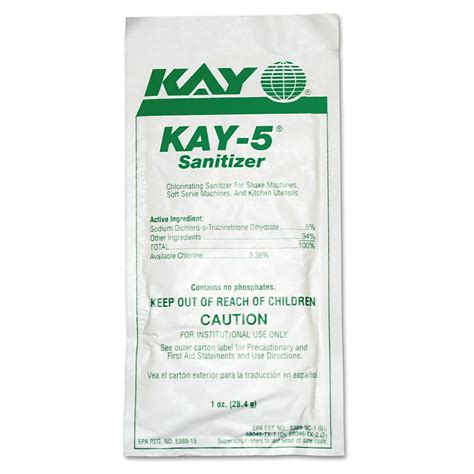Kay-5 Sanitizer: Is It Right for Your Needs?
Kay-5 sanitizer has gained popularity as a versatile disinfectant, but is it the right choice for your specific needs? This comprehensive guide will delve into the features, applications, and considerations to help you determine if Kay-5 is the ideal sanitizer for your home, business, or other environment.
Before we dive in, it's important to note that "Kay-5" isn't a universally recognized brand name like Lysol or Clorox. This article will assume you're referring to a specific product containing a 5% concentration of a particular active ingredient, likely a quaternary ammonium compound (quat) or a blend of disinfectants. Always check the product label for the exact composition and intended uses. Using the wrong sanitizer for a specific purpose can be ineffective or even harmful.
What is Kay-5 Sanitizer (Assuming 5% Active Ingredient)?
Kay-5 sanitizer, assuming it refers to a product with a 5% active ingredient concentration, typically falls under the category of broad-spectrum disinfectants. This means it's designed to kill a wide range of microorganisms, including bacteria and viruses. The specific effectiveness against particular pathogens (like specific strains of influenza or norovirus) will depend on the active ingredient(s) listed on the product label. Always refer to the manufacturer's instructions for specific claims.
What are the Applications of Kay-5 Sanitizer?
The suitability of Kay-5 sanitizer depends heavily on its specific formulation and the claims made by the manufacturer. However, general applications for this type of disinfectant often include:
- Hard surfaces: Sanitizing countertops, tables, floors, and other non-porous surfaces in homes, offices, and businesses.
- Food contact surfaces (with caution): Some formulations may be suitable for use on surfaces that come into contact with food, but always check the label to ensure it's explicitly approved for this purpose and follow instructions meticulously. Improper use could lead to food contamination.
- Equipment sanitization: Depending on the formulation and manufacturer's claims, it might be suitable for sanitizing certain equipment in commercial settings.
Is Kay-5 Sanitizer Effective Against Viruses?
This is a crucial question. Many disinfectants claim broad-spectrum activity, but the effectiveness against viruses, particularly enveloped viruses like the influenza virus or coronaviruses, depends on the active ingredient and the contact time. The product label should clearly state its virucidal properties. Simply having "5%" of an active ingredient doesn't automatically guarantee effectiveness against all viruses. The specific virus needs to be listed on the label for the claim to be valid.
What are the active ingredients in Kay-5 Sanitizer?
The specific active ingredients will determine the sanitizer's efficacy. Common active ingredients in disinfectants include quaternary ammonium compounds (quats), alcohols (like ethanol or isopropanol), and bleach (sodium hypochlorite). Each has different strengths and weaknesses against various microorganisms. Check the product label for a complete list of ingredients and their concentrations.
How long does it take for Kay-5 Sanitizer to work?
The contact time—the amount of time the disinfectant needs to remain wet on the surface—is critical for effectiveness. The label will specify the required contact time for the disinfectant to achieve its claimed level of disinfection. Thoroughly wetting the surface and allowing sufficient contact time is essential. Don't rinse or wipe it away prematurely.
Is Kay-5 Sanitizer safe for use around children and pets?
Always follow the manufacturer's safety precautions. Keep Kay-5 sanitizer out of reach of children and pets. If ingested, contact a poison control center immediately. Adequate ventilation is crucial when using any disinfectant. Never mix different cleaning products, as this can create dangerous fumes.
What are the alternatives to Kay-5 Sanitizer?
Numerous other disinfectants are available, each with its own strengths and weaknesses. Consider alternatives based on your specific needs and the types of microorganisms you need to eliminate. Other options include disinfectants based on alcohol, bleach, or other active ingredients. Consult your local health authority for recommendations.
By carefully considering the specific formulation of your Kay-5 sanitizer and consulting the manufacturer's instructions, you can make an informed decision on whether it meets your needs. Remember, responsible use and adherence to safety guidelines are paramount.

